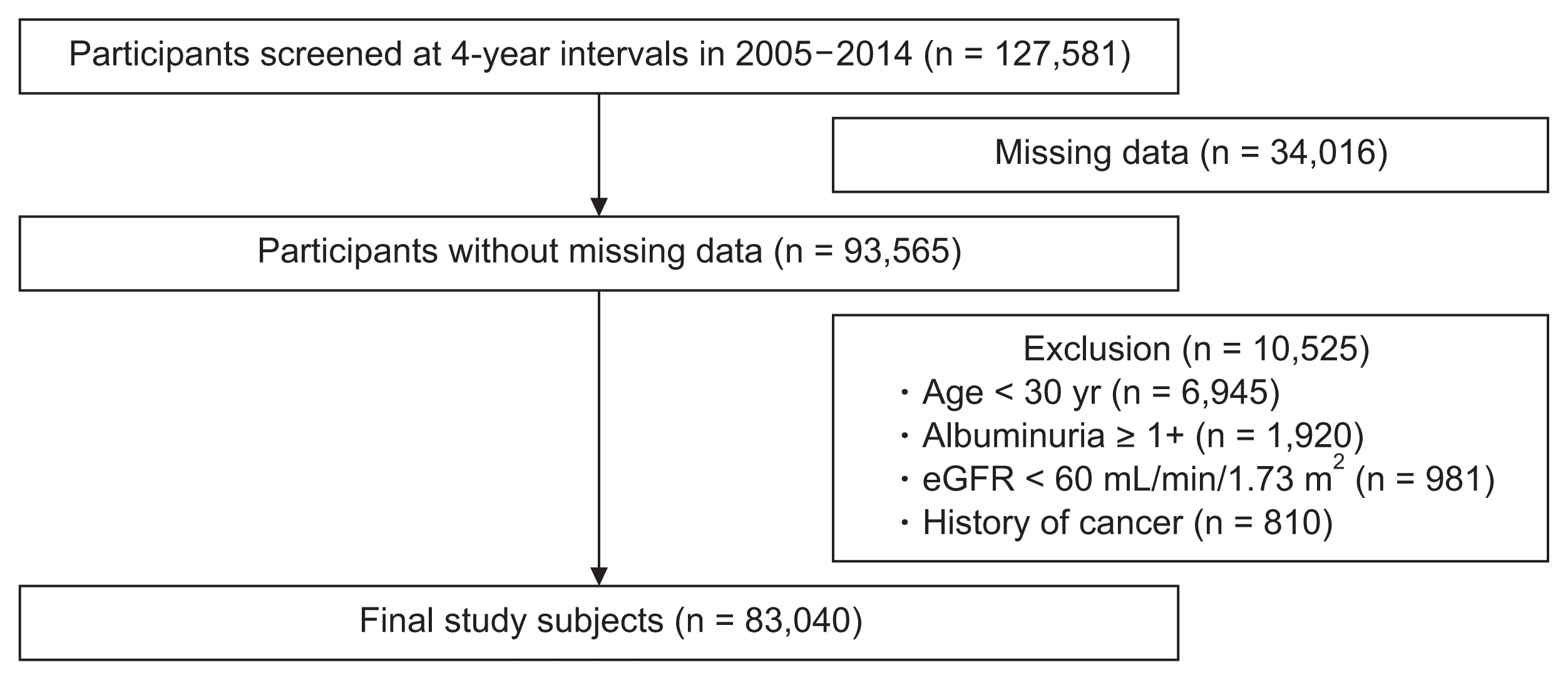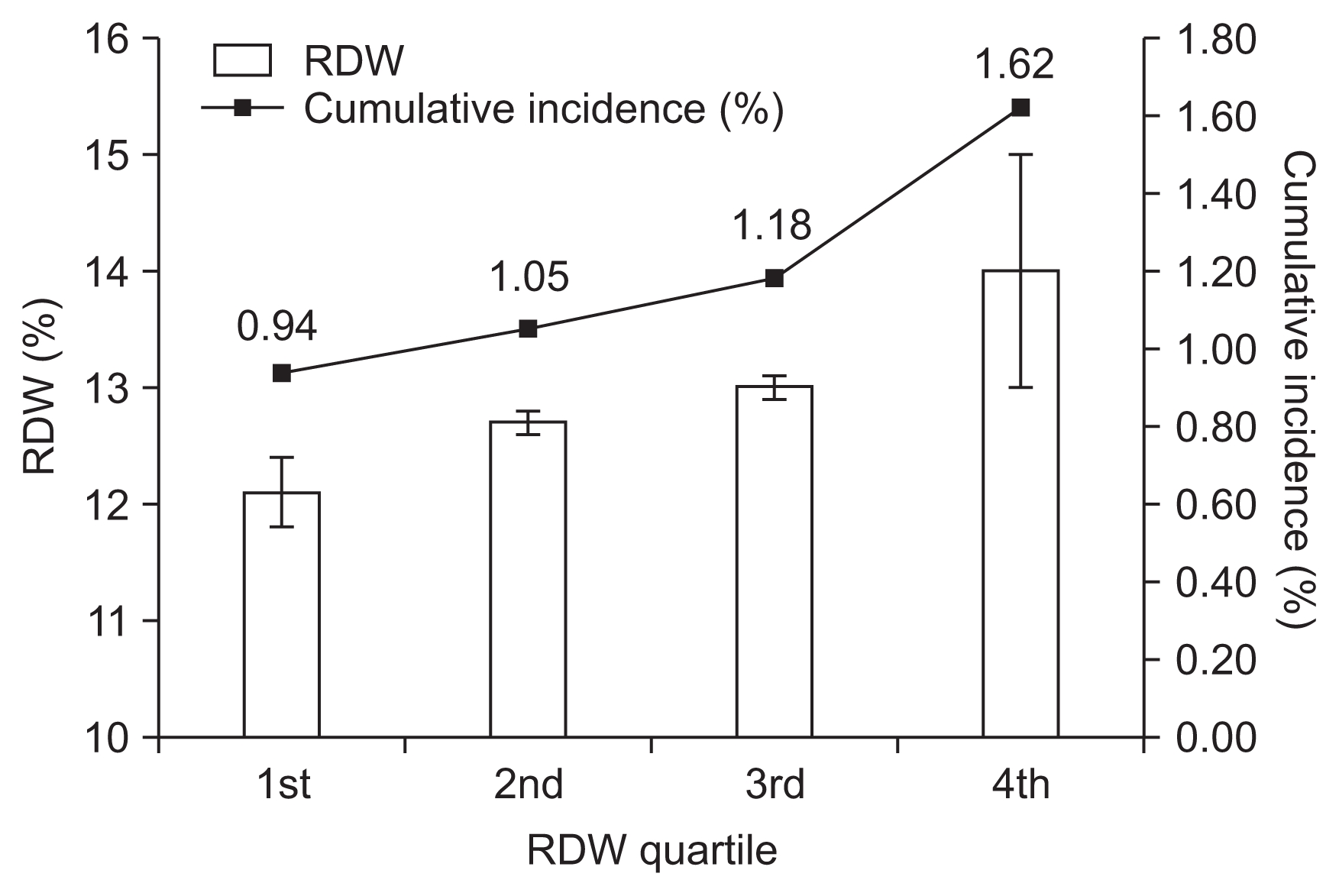1. Sarma PR. Red cell indices. In: Walker HK, Hall WD, Hurst JW, Clinical methods. 3th edition. Boston: Butter-worths; p. 720ŌĆō723. 1990.
2. Marks PW. Approach to anemia in the adult and child. In: Hoffman R, Benz EJ, Silberstein LE, Heslop H, Weitz J, Anastasi J, Hematology: basic principles and practice. 6th edition. Philadelphia, PA: Elsevier/Saunders; p. 418ŌĆō426. 2013.
3. Danese E, Lippi G, Montagnana M. Red blood cell distribution width and cardiovascular diseases.
J Thorac Dis 7:E402ŌĆōE411. 2015;


4. Salvagno GL, Sanchis-Gomar F, Picanza A, Lippi G. Red blood cell distribution width: A simple parameter with multiple clinical applications.
Crit Rev Clin Lab Sci 52:86ŌĆō105. 2015;


5. Mucsi I, Ujszaszi A, Czira ME, Novak M, Molnar MZ. Red cell distribution width is associated with mortality in kidney transplant recipients.
Int Urol Nephrol 46:641ŌĆō651. 2014;


6. Hsieh YP, Chang CC, Kor CT, Yang Y, Wen YK, Chiu PF. The predictive role of red cell distribution width in mortality among chronic kidney disease patients.
PLoS One 11:e01620252016;



7. Sun IO, Chung BH, Yoon HJ, Kim JH, Choi BS, Park CW, Kim YS, Yang CW, Lee KY. Clinical significance of red blood cell distribution width in the prediction of mortality in patients on peritoneal dialysis.
Kidney Res Clin Pract 35:114ŌĆō118. 2016;



8. Vashistha T, Streja E, Molnar MZ, Rhee CM, Moradi H, Soohoo M, Kovesdy CP, Kalantar-Zadeh K. Red cell distribution width and mortality in hemodialysis patients.
Am J Kidney Dis 68:110ŌĆō121. 2016;



9. Akin F, Celik O, Altun I, Ayca B, Ozturk D, Satilmis S, Ayaz A, Tasbulak O. Relation of red cell distribution width to contrast-induced acute kidney injury in patients undergoing a primary percutaneous coronary intervention.
Coron Artery Dis 26:289ŌĆō295. 2015;


10. Kurtul A, Yarlioglues M, Murat SN, Demircelik MB, Acikgoz SK, Ergun G, Duran M, Cetin M, Ornek E. Red cell distribution width predicts contrast-induced nephropathy in patients undergoing percutaneous coronary intervention for acute coronary syndrome.
Angiology 66:433ŌĆō440. 2015;


11. Basi S, Fesler P, Mimran A, Lewis JB. Microalbuminuria in type 2 diabetes and hypertension: a marker, treatment target, or innocent bystander?
Diabetes Care 31:Suppl 2. S194ŌĆōS201. 2008;


12. KDIGO. KDIGO 2012 clinical practice guideline for the evaluation and management of chronic kidney disease. Kidney Int Suppl 3:1ŌĆō150. 2013.
13. Burton C, Harris KP. The role of proteinuria in the progression of chronic renal failure.
Am J Kidney Dis 27:765ŌĆō775. 1996;


14. Matsushita K, van der Velde M, Astor BC, Woodward M, Levey AS, de Jong PE, Coresh J, Gansevoort RT. Chronic Kidney Disease Prognosis Consortium. Association of estimated glomerular filtration rate and albuminuria with all-cause and cardiovascular mortality in general population cohorts: a collaborative meta-analysis.
Lancet 375:2073ŌĆō2081. 2010;



15. Zhang M, Zhang Y, Li C, He L. Association between red blood cell distribution and renal function in patients with untreated type 2 diabetes mellitus.
Ren Fail 37:659ŌĆō663. 2015;


16. Cheng D, Zhao J, Jian L, Ding T, Liu S. Relationship between red cell distribution width and early renal injury in patients with gestational diabetes mellitus.
Ren Fail 38:1218ŌĆō1223. 2016;


17. Pusuroglu H, Akgul O, Erturk M, Surgit O, Tasbulak O, Akkaya E, Yazan S, G├╝l M, T├╝ren S. Red cell distribution width and end-organ damage in patients with systo-diastolic hypertension.
Arch Med Sci 12:319ŌĆō325. 2016;



18. Afonso L, Zalawadiya SK, Veeranna V, Panaich SS, Niraj A, Jacob S. Relationship between red cell distribution width and microalbuminuria: a population-based study of multiethnic representative US adults.
Nephron Clin Pract 119:c277ŌĆōc282. 2011;


19. Levey AS, Bosch JP, Lewis JB, Greene T, Rogers N, Roth D. A more accurate method to estimate glomerular filtration rate from serum creatinine: a new prediction equation. Modification of Diet in Renal Disease Study Group.
Ann Intern Med 130:461ŌĆō470. 1999;


20. Levey AS, Coresh J, Greene T, Stevens LA, Zhang YL, Hendriksen S, Kusek JW, Van Lente F. Chronic Kidney Disease Epidemiology Collaboration. Using standardized serum creatinine values in the modification of diet in renal disease study equation for estimating glomerular filtration rate.
Ann Intern Med 145:247ŌĆō254. 2006;


21. Lippi G, Targher G, Montagnana M, Salvagno GL, Zoppini G, Guidi GC. Relationship between red blood cell distribution width and kidney function tests in a large cohort of unselected outpatients.
Scand J Clin Lab Invest 68:745ŌĆō748. 2008;


22. Ujszaszi A, Molnar MZ, Czira ME, Novak M, Mucsi I. Renal function is independently associated with red cell distribution width in kidney transplant recipients: a potential new auxiliary parameter for the clinical evaluation of patients with chronic kidney disease.
Br J Haematol 161:715ŌĆō725. 2013;


23. Li ZZ, Chen L, Yuan H, Zhou T, Kuang ZM. Relationship between red blood cell distribution width and early-stage renal function damage in patients with essential hypertension.
J Hypertens 32:2450ŌĆō2455. discussion 2456. 2014


24. Jang CM, Hyun YY, Lee KB, Kim H. The association between underweight and the development of albuminuria is different between sexes in relatively healthy Korean subjects.
Nephrol Dial Transplant 29:2106ŌĆō2113. 2014;


25. Patel KV, Semba RD, Ferrucci L, Newman AB, Fried LP, Wallace RB, Bandinelli S, Phillips CS, Yu B, Connelly S, Shlipak MG, Chaves PH, Launer LJ, Ershler WB, Harris TB, Longo DL, Guralnik JM. Red cell distribution width and mortality in older adults: a meta-analysis.
J Gerontol A Biol Sci Med Sci 65:258ŌĆō265. 2010;


26. Montagnana M, Cervellin G, Meschi T, Lippi G. The role of red blood cell distribution width in cardiovascular and thrombotic disorders.
Clin Chem Lab Med 50:635ŌĆō641. 2011.


27. Upadhyay A, Larson MG, Guo CY, Vasan RS, Lipinska I, OŌĆÖDonnell CJ, Kathiresan S, Meigs JB, Keaney JF Jr, Rong J, Benjamin EJ, Fox CS. Inflammation, kidney function and albuminuria in the Framingham Offspring cohort.
Nephrol Dial Transplant 26:920ŌĆō926. 2011;


28. Ruiz-Hurtado G, Condezo-Hoyos L, Pulido-Olmo H, Aranguez I, Del Carmen, G├│nzalez M, Arribas S, Cerezo C, Segura J, Praga M, Fern├Īndez-Alfonso MS, Ruilope LM. Development of albuminuria and enhancement of oxidative stress during chronic renin-angiotensin system suppression.
J Hypertens 32:2082ŌĆō2091. discussion 2091. 2014


29. Patel KV, Mohanty JG, Kanapuru B, Hesdorffer C, Ershler WB, Rifkind JM. Association of the red cell distribution width with red blood cell deformability.
Adv Exp Med Biol 765:211ŌĆō216. 2013;



30. Solak Y, Yilmaz MI, Saglam M, Caglar K, Verim S, Unal HU, Gok M, Demirkaya E, Gaipov A, Kayrak M, Cetinkaya H, Eyileten T, Turk S, Vural A. Red cell distribution width is independently related to endothelial dysfunction in patients with chronic kidney disease.
Am J Med Sci 347:118ŌĆō124. 2014;


31. Shao Y, Lv C, Yuan Q, Wang Q. Levels of serum 25(OH)VD3, HIF-1╬▒, VEGF, vWf, and IGF-1 and their correlation in type 2 diabetes patients with different urine albumin creatinine ratio.
J Diabetes Res 2016:19254242016;



32. Lamarca B. Endothelial dysfunction. An important mediator in the pathophysiology of hypertension during pre-eclampsia.
Minerva Ginecol 64:309ŌĆō320. 2012;


33. Israni AK, Kasiske B. Laboratory assessment of kidney disease: glomerular filtration rate, urinalysis, and proteinuria. In: Taal MW, Chertow GM, Marsden PA, Skorecki K, Yu ASL, Brenner BM, Brenner and RectorŌĆÖs The Kidney. 9th edition. Philadelphia, PA: Elsevier Saunders; 887:2012.





 PDF Links
PDF Links PubReader
PubReader Full text via DOI
Full text via DOI Download Citation
Download Citation Print
Print
















